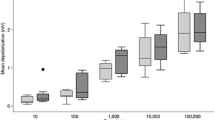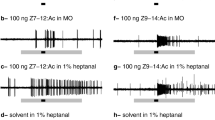Abstract
Experience modifies behaviour in animals so that they adapt to their environment. In male noctuid moths, Spodoptera littoralis, brief pre-exposure to various behaviourally relevant sensory signals modifies subsequent behaviour towards the same or different sensory modalities. Correlated with a behavioural increase in responses of male moths to the female-emitted sex pheromone after pre-exposure to olfactory, acoustic or gustatory stimuli, an increase in sensitivity of olfactory neurons within the primary olfactory centre, the antennal lobe, is found for olfactory and acoustic stimuli, but not for gustatory stimuli. Here, we investigated whether anatomical changes occurring in the antennal lobes and in the mushroom bodies (the secondary olfactory centres) possibly correlated with the changes observed in behaviour and in olfactory neuron physiology. Our results showed that significant volume changes occurred in glomeruli (olfactory units) responsive to sex pheromone following exposure to both pheromone and predator sounds. The volume of the mushroom body input region (calyx) also increased significantly after pheromone and predator sound treatment. However, we found no changes in the volume of antennal lobe glomeruli or of the mushroom body calyx after pre-exposure to sucrose. These findings show a relationship of antennal lobe sensitivity changes to the pheromone with changes in the volume of the related glomeruli and the output area of antennal lobe projection neurons elicited by sensory cues causing a behavioural change. Behavioural changes observed after sucrose pre-exposure must originate from changes in higher integration centres in the brain.



Similar content being viewed by others
References
Anderson P, Sadek M, Hansson B (2003) Pre-exposure modulates attraction to sex pheromone in a moth. Chem Senses 28:285–291
Anderson P, Hansson BS, Nilsson U, Han Q, Sjöholm M, Skals N, Anton S (2007) Increased behavioral and neuronal sensitivity to sex pheromone after brief odor experience in a moth. Chem Senses 32:483–491
Anton S, Evengaard K, Barrozo RB, Anderson P, Skals N (2011) Brief predator sound exposure elicits behavioral and neuronal long-term sensitization in the olfactory system of an insect. Proc Natl Acad Sci U S A 108:3401–3405
Brown S, Napper R, Mercer A (2004) Foraging experience, glomerulus volume, and synapse number: a stereological study of the honey bee antennal lobe. J Neurobiol 60:40–50
Busto GUG, Cervantes-Sandoval II, Davis RLR (2010) Olfactory learning in Drosophila. Annu Rev Physiol 25:338–346
Couton L, Minoli S, Kieu K, Anton S, Rospars J-P (2009) Constancy and variability of identified glomeruli in antennal lobes: computational approach in Spodoptera littoralis. Cell Tissue Res 337:491–511
Devaud J-M, Acebes A, Ferrús A (2001) Odor exposure causes central adaptation and morphological changes in selected olfactory glomeruli in Drosophila. J Neurosci 21:6274–6282
Devaud J-M, Acebes A, Ramaswami M, Ferrús A (2003) Structural and functional changes in the olfactory pathway of adult Drosophila take place at a critical age. J Neurobiol 56:13–23
Fan R, Anderson P, Hansson B (1997) Behavioural analysis of olfactory conditioning in the moth Spodoptera littoralis (Boisd.) (Lepidoptera : Noctuidae). J Exp Biol 200:2969–2976
Farris SM, Robinson GE, Fahrbach SE (2001) Experience- and age-related ourgrowth of intrinsic neurons in the mushroom bodies of the adult worker honeybee. J Neurosci 21:6395–6404
Fox K, Wong R (2005) A comparison of experience-dependent plasticity in the visual and somatosensory systems. Neuron 48:465–477
Giurfa MM (2007) Behavioral and neural analysis of associative learning in the honeybee: a taste from the magic well. J Comp Physiol A 193:801–824
Groh C, Meinertzhagen IA (2010) Brain plasticity in Diptera and Hymenoptera. Frontiers Biosci 2:268–288
Groh C, Lu Z, Meinertzhagen IA, Rössler W (2012) Age-related plasticity in the synaptic ultrastructure of neurons in the mushroom body calyx of the adult honeybee Apis mellifera. J Comp Neurol 520:3509–3527
Gronenberg W (2001) Subdivisions of hymenopteran mushroom body calyces by their afferent supply. J Comp Neurol 435:474–489
Grubb MS, Thompson ID (2004) The influence of early experience on the development of sensory systems. Curr Opin Neurobiol 14:503–512
Guerrieri F, Gemeno C, Monsempes C, Anton S, Jacquin-Joly E, Lucas P, Devaud J-M (2012) Experience-dependent modulation of antennal sensitivity and input to antennal lobes in male moths (Spodoptera littoralis) pre-exposed to sex pheromone. J Exp Biol 215:2334–2341
Hammer M (1993) An identified neuron mediates the unconditioned stimulus in associative olfactory learning in honeybees. Nature 366:59–63
Han Q, Hansson BS, Anton S (2005) Interactions of mechanical stimuli and sex pheromone information in antennal lobe neurons of a male moth, Spodoptera littoralis. J Comp Physiol A 191:521–528
Hartlieb E, Hansson B, Anderson P (1999) Sex or food? Appetetive learning of sex odors in a male moth. Naturwissenschaften 86:396–399
Hourcade B, Perisse E, Devaud J-M, Sandoz J-C (2009) Long-term memory shapes the primary olfactory center of an insect brain. Learn Mem 16:607–615
Hourcade B, Muenz TS, Sandoz J-C, Rössler W, Devaud J-M (2010) Long-term memory leads to synaptic reorganization in the mushroom bodies: a memory trace in the insect brain? J Neurosci 30:6461–6465
Huetteroth W, Perisse E, Lin S, Klappenbach M, Burke C, Waddell S (2015) Sweet taste and nutrient value subdivide rewarding dopaminergic neurons in Drosophila. Curr Biol 25:751–758
Jones BM, Leonard AS, Papaj DR, Gronenberg W (2013) Plasticity of the worker bumblebee brain in relation to age and rearing environment. Brain Behav Evol 82:250–261
Jorgensen K, Almaas TJ, Marion-Poll F, Mustaparta H (2007) Electrophysiological characterization of responses from gustatory receptor neurons of sensilla chaetica in the moth Heliothis virescens. Chem Senses 32:863–879
Kandel E (2001) Neuroscience—the molecular biology of memory storage: a dialogue between genes and synapses. Science 294:1030–1038
Kromann SH, Saveer AM, Binyameen M, Bengtsson M, Birgersson G, Hansson BS, Schlyter F, Witzgall P, Ignell R, Becher PG (2015) Concurrent modulation of neuronal and behavioural olfactory responses to sex and host plant cues in a male moth. Proc Biol Sci 282:20141884
Kvello P, Jorgensen K, Mustaparta H (2010) Central gustatory neurons integrate taste quality information from four appendages in the moth Heliothis virescens. J Neurophysiol 103:2965–2981
Landgrebe M, Nyuyki K, Frank E, Steffens T, Hauser S, Eichhammer P, Hajak G, Langguth B (2008) Effects of colour exposure on auditory and somatosensory perception—hints for cross-modal plasticity. Neuro Endocrinol Lett 29:518–521
Liu C, Plaçais P-Y, Yamagata N, Pfeiffer BD, Aso Y, Friedrich AB, Siwanowicz I, Rubin GM, Preat T, Tanimoto H (2012) A subset of dopamine neurons signals reward for odour memory in Drosophila. Nature 488:512–516
Menzel R (2001) Searching for the memory trace in a mini-brain, the honeybee. Learn Mem 8:53–62
Minoli S, Kauer I, Colson V, Party V, Renou M, Anderson P, Gadenne C, Marion-Poll F, Anton S (2012) Brief exposure to sensory cues elicits stimulus-nonspecific general sensitization in an insect. PLoS ONE 7:e34141
Pfuhl G, Zhao XC, Ian E, Surlykke A, Berg BG (2014) Sound-sensitive neurons innervate the ventro-lateral protocerebrum of the heliothine moth brain. Cell Tissue Res 355:289–302
Popescu A, Couton L, Almaas T-J, Rospars J-P, Wright GA, Marion-Poll F, Anton S (2013) Function and central projections of gustatory receptor neurons on the antenna of the noctuid moth Spodoptera littoralis. J Comp Physiol A 199:403–416
Sachse S, Rueckert E, Okada R, Tanaka N, Ito K, Vosshall LB (2007) Activity-dependent plasticity in an olfactory circuit. Neuron 56:838–850
Saveer AM, Kromann SH, Birgersson G, Bengtsson M, Lindblom T, Balkenius A, Hansson BS, Witzgall P, Becher PG, Ignell R (2012) Floral to green: mating switches moth olfactory coding and preference. Proc Biol Sci 279:2314–2322
Scholl C, Wang Y, Krischke M, Mueller MJ, Amdam GV, Rössler W (2014) Light exposure leads to reorganization of microglomeruli in the mushroom bodies and influences juvenile hormone levels in the honeybee. Dev Neurobiol 74:1141–1153
Schröter U, Menzel R (2003) A new ascending sensory tract to the calyces of the honeybee mushroom body, the subesophageal-calycal tract. J Comp Neurol 465:168–178
Stieb SM, Muenz TS, Wehner R, Rössler W (2010) Visual experience and age affect synaptic organization in the mushroom bodies of the desert ant Cataglyphis fortis. Dev Neurobiol 70:408–423
Yu L, Stein BE, Rowland BA (2009) Adult plasticity in multisensory neurons: short-term experience-dependent changes in the superior colliculus. J Neurosci 29:15910–15922
Acknowledgments
We thank Fabien Tissier, Pascal Roskam and Jean-Christophe François for insect rearing.
Author information
Authors and Affiliations
Corresponding author
Additional information
This project was supported by the French National Funding Agency Grant ANR-07-Neuro-037-01.
Rights and permissions
About this article
Cite this article
Anton, S., Chabaud, MA., Schmidt-Büsser, D. et al. Brief sensory experience differentially affects the volume of olfactory brain centres in a moth. Cell Tissue Res 364, 59–65 (2016). https://doi.org/10.1007/s00441-015-2299-0
Received:
Accepted:
Published:
Issue Date:
DOI: https://doi.org/10.1007/s00441-015-2299-0




